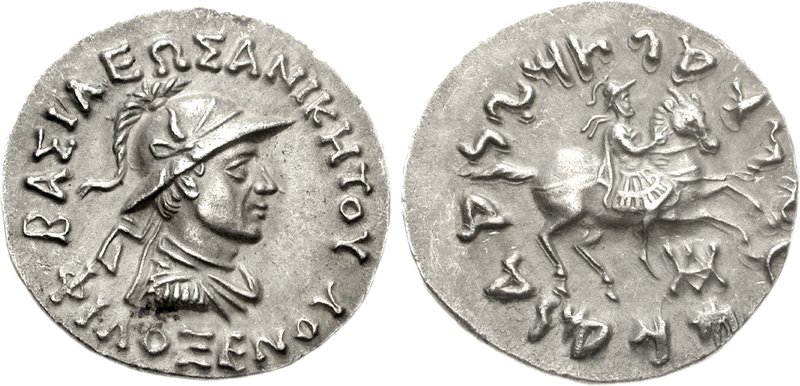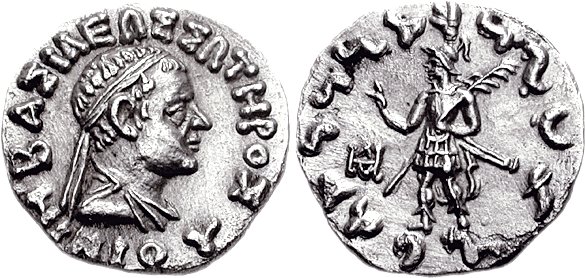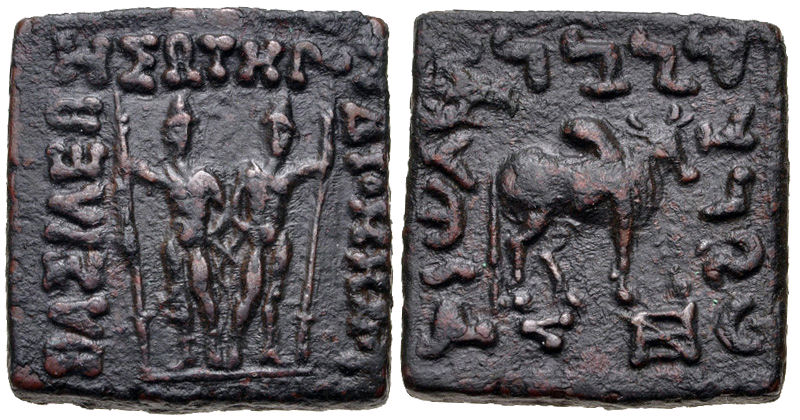|
Philoxenios
Philoxenus Anicetus (Greek: ; epithet means "the Invincible") was an Indo-Greek king who ruled in the region spanning the Paropamisade to Punjab. Philoxenus seems to have been quite an important king who might briefly have ruled most of the Indo-Greek territory. Bopearachchi dates Philoxenus to c. 100–95 BCE and R. C. Senior to c. 125–110 BCE. Historians have not yet connected Philoxenus with any dynasty, but he could have been the father of the princess Kalliope, who was married to the king Hermaeus. Coins of Philoxenos Philoxenus struck several series of bilingual Indian silver coins, with a reverse of a mounted king, a type previously used as obverse by Antimachus II sixty years earlier and as reverse on rare types of Nicias. Whether the horseman was a dynastic emblem or a portrait of the king as a cavalryman is unclear. Several Saka kings used similar horsemen on their coinage. His drachms were square, another feature that was rare among Indo-Greeks but standard for ... [...More Info...] [...Related Items...] OR: [Wikipedia] [Google] [Baidu] |
Indo-Greek
The Indo-Greek Kingdom, or Graeco-Indian Kingdom, also known historically as the Yavana Kingdom (Yavanarajya), was a Hellenistic period, Hellenistic-era Ancient Greece, Greek kingdom covering various parts of Afghanistan and the northwestern regions of the Indian subcontinent (parts of modern-day Pakistan and northwestern India). This kingdom was in existence from ca. 200 BC to ca. 1 BC. During its existence the kingdom was ruled over by 30 successive kings. Menander I, being the most well known amongst the Indo-Greek kings, is often referred to simply as ''“Menander,”'' despite the fact that there was indeed another Indo-Greek King known as Menander II. Menander I's capital was at Sagala in the Punjab region, Punjab (present-day Sialkot). The kingdom was founded when the Graeco-Bactrian king Demetrius I of Bactria, Demetrius (and later Eucratides I, Eucratides) invaded India from Bactria in 200 BC. The Greeks in the Indian Subcontinent were eventually divided from the G ... [...More Info...] [...Related Items...] OR: [Wikipedia] [Google] [Baidu] |
King Nicias
Nicias (Greek: ) was an Indo-Greek king who ruled in the Paropamisade. Most of his relatively few coins have been found in northern Pakistan, indicating that he ruled a smaller principate around the lower Kabul valley. He was possibly a relative of Menander I. Time of reign Bopearachchi suggests that Nicias ruled c. 90–85 BCE. This late date is supported by the absence of Attic coins (see below). R. C. Senior on the other hand places him as a successor of Menander, c. 135–125 BCE, according to his interpretation of hoard findings. Regardless of which period is correct, the fact that Nicias ages visibly on his coins seems to indicate some longevity to his rule. The coinage of Nicias Nicias struck Indian silver drachms of diademed or helmeted king with three reverses: *A standing king in armour making a blessing gesture, found on several drachms. *An en face version of Menander's Athena with thunderbolt is found on a unique tetradrachm. *The third reverse is the type king on ... [...More Info...] [...Related Items...] OR: [Wikipedia] [Google] [Baidu] |
Japan Currency Museum
__NOTOC__ The , formally known as the is a museum about Japanese currency located in front of the Bank of Japan building in Chūō, Tokyo. The museum opened in November 1985.Edan CorkillBank of Japan Currency Museum invests in exhibition on wallets ''Japan Times'', 13 August 2010. In 2010, there was an exhibition of wallets from the Edo Period (1603–1867) and Meiji Era (1868–1912). Gallery File:Wadokaichin coin 8th century Japan.jpg, Wadōkaichin coin from 8th century Japan. File:Philoxenus Indo Greek square coin.jpg, Philoxenus Indo-Greek coin in the Indian square standard. File:Antialcidas Indo Greek coin.jpg, Antialcidas wearing the kausia. See also * Japanese currency * List of museums in Tokyo The following is a list of museums and art galleries in Tokyo. See also * List of museums in Japan Resources {{Commons category, Museums in Tokyo Tokyo Tourism InformationTravel Tokyo Culture in Tokyo Tokyo Museums, Tokyo Museums ... References Exte ... [...More Info...] [...Related Items...] OR: [Wikipedia] [Google] [Baidu] |
Demetrius III Aniketos
Demetrius III Aniketos (Greek: ; epithet means "the Invincible") is an Indo-Greek king who reigned in the area of Gandhara and Punjab. Controversy about time of reign The coins of Demetrius III are few and rather crude. He copies some of his imagery from the renowned Bactrian king Demetrius I (c. 200–180 BCE). The two namesakes share the war-like epithet ''"The Invincible"'' and wear elephant-crowns, the symbol that Alexander the Great used to celebrate his conquest of the Indus Valley. The historical sources of the Indo-Greek kingdom are very few, and the separation of kings with the same name is not an easy process. Numismatician Osmund Bopearachchi identifies three kings named Demetrius, placing the third around 100 BCE due to mintmarks and style of the coins (see discussion under Demetrius II). R C Senior agrees with this reconstruction, even though their dates are somewhat different: according to Bopearachchi he ruled around 100 BCE, whereas R. C. Senior places him circ ... [...More Info...] [...Related Items...] OR: [Wikipedia] [Google] [Baidu] |
Amyntas Nikator
Amyntas Nicator ( grc, Ἀμύντας Νικάτωρ, Amyntas Nikatōr; epithet means "the Conqueror") was an Indo-Greek king. His coins have been found both in eastern Punjab and Afghanistan, indicating that he ruled a considerable territory. Date Bopearachchi places Amyntas c. 95–90 BCE, whereas Senior places him c. 80–65 BCE. Coinage Amyntas struck bilingual silver coins with a variety of portraits. Most of these bear the reverse of sitting Zeus holding a victory palm and a small statue of Athena, which according to RC Senior may have indicated an alliance between the house of Menander I and the house of Antialcidas. Some of his coins feature the reverse of fighting Athena typical for Menander's descendants. The epithet Nikator (Victor) was previously only used on the Bactrian coins of Agathocles, a century before Amyntas' reign. His bronzes feature the syncretic deity Zeus-Mithra wearing a phrygian cap and Athena standing at rest, both forming the vitarka mudra. Amy ... [...More Info...] [...Related Items...] OR: [Wikipedia] [Google] [Baidu] |
King Diomedes
Diomedes Soter or Diodotus (Greek: ; epithet means "the Saviour") was an Indo-Greek king and possible claimant Greco-Bactrian King who may have attempted to reconquer the lands north of the Hindu Kush. The places where his coins have been found seem to indicate that his rule was based in the area of the Paropamisadae, possibly with temporary dominions further east. Judging from their similar portraits and many overlapping monograms, the young Diomedes seems to have been the heir (and probably a relative) of Philoxenus, the last king to rule before the kingdom of Menander I finally fragmented. Time of reign Bopearachchi dates Diomedes to c. 95–90 BCE and R. C. Senior dates him to c. 115–105 BCE. Coins of Diomedes (Diodotus) Diomedes either born Diodotus or reigning as such; perhaps erroneously labelled on legend as Diomedes, is depicted with the Dioscuri on his coins, either on horseback or standing; both types were previously used by Eucratides the Great, which strongly s ... [...More Info...] [...Related Items...] OR: [Wikipedia] [Google] [Baidu] |
Paropamisadae
Paropamisadae or Parapamisadae (Greek: Παροπαμισάδαι) was a satrapy of the Alexandrian Empire in modern Afghanistan and Pakistan, which largely coincided with the Achaemenid province of Parupraesanna. It consisted of the districts of Sattagydia (Bannu basin), Gandhara (Kabul, Peshawar, and Taxila), and Oddiyana (Swat Valley). Paruparaesanna is mentioned in the Akkadian language and Elamite language versions of the Behistun Inscription of Darius the Great, whereas in the Old Persian version it is called Gandāra. The entire satrapy was subsequently ceded by Seleucus I Nicator to Chandragupta Maurya following a treaty. Name ''Paropamisadae'' is the Latinized form of the Greek name ''Paropamisádai'' (), which is in turn derived from Old Persian ''Para-uparisaina'', meaning "Beyond the Hindu Kush", where the Hindu Kush is referred to as ''Uparisaina'' ("higher than the eagle"). In the Greek language and Latin, "Paropamisus" Mela, ''De Situ Orbis'', Bk. I, Ch. 15, � ... [...More Info...] [...Related Items...] OR: [Wikipedia] [Google] [Baidu] |
Gandhara
Gandhāra is the name of an ancient region located in the northwestern region of the Indian subcontinent, more precisely in present-day north-west Pakistan and parts of south-east Afghanistan. The region centered around the Peshawar Valley and Swat river valley, though the cultural influence of "Greater Gandhara" extended across the Indus river to the Taxila region in Potohar Plateau and westwards into the Kabul Valley in Afghanistan, and northwards up to the Karakoram range. Gandhara has a deep rooted history of Hinduism mentioned in Indian scripts and epics including Rig Veda, Ramayana and Mahabharata. Famed for its unique Gandharan style of art which is influenced by the classical Hellenistic styles, Gandhara attained its height from the 1st century to the 5th century CE under the Kushan Empire, who had their capital at Peshawar (''Puruṣapura''). Gandhara "flourished at the crossroads of India, Central Asia, and the Middle East," connecting trade routes and absor ... [...More Info...] [...Related Items...] OR: [Wikipedia] [Google] [Baidu] |
Arachosia
Arachosia () is the Hellenized name of an ancient satrapy situated in the eastern parts of the Achaemenid empire. It was centred around the valley of the Arghandab River in modern-day southern Afghanistan, and extended as far east as the Indus River, in modern-day Pakistan. The Old Persian form of its name is ''Harauvatiš'', being the etymological equivalent of Vedic Sanskrit ''Sárasvatī''. The province name is derived after its main river, the modern Arghandab (in Greek called Arachōtós), a tributary of the Helmand river. The capital of Arachosia was Alexandria of Arachosia, an ancient Greek city that was situated over what is now known as Kandahar. Etymology "Arachosia" is the Latinized form of Greek (''Arachōsíā''). "The same region appears in the Avestan '' Vidēvdāt'' (1.12) under the indigenous dialect form 𐬵𐬀𐬭𐬀𐬓𐬀𐬌𐬙𐬍 - (whose ''-axva-'' is typical non-Avestan)." In Old Persian inscriptions, the region is referred to as 𐏃 ... [...More Info...] [...Related Items...] OR: [Wikipedia] [Google] [Baidu] |
Antialcidas
Antialcidas Nikephoros ( grc, Ἀντιαλκίδας ὁ Νικηφόρος; epithet means "the Victorious", Brahmi: 𑀅𑀁𑀢𑀮𑀺𑀓𑀺𑀢𑀲 ''Aṃtalikitasa'', in the Heliodorus Pillar) was a king of the Indo-Greek Kingdom, who reigned from his capital at Taxila. Bopearachchi has suggested that he ruled from ca. 115 to 95 BCE in the western parts of the Indo-Greek realms, whereas R. C. Senior places him around 130 to 120 BCE and also in eastern Punjab (which seems better supported by coin findings). Senior does however believe that he ruled in tandem with King Lysias. Genealogy Antialcidas may have been a relative of the Greco-Bactrian king Heliocles I, but ruled after the fall of the Greco-Bactrian kingdom. Several later kings may have been related to Antialcidas: Heliokles II, Amyntas, Diomedes and Hermaeus all struck coins with similar features. The Heliodorus inscription Though there are few sources for the late Indo-Greek history, Antialcidas is known fro ... [...More Info...] [...Related Items...] OR: [Wikipedia] [Google] [Baidu] |
Kushan Empire
The Kushan Empire ( grc, Βασιλεία Κοσσανῶν; xbc, Κυϸανο, ; sa, कुषाण वंश; Brahmi: , '; BHS: ; xpr, 𐭊𐭅𐭔𐭍 𐭇𐭔𐭕𐭓, ; zh, 貴霜 ) was a syncretic empire, formed by the Yuezhi, in the Bactrian territories in the early 1st century. It spread to encompass much of modern-day territory of, Afghanistan, Pakistan, Uzbekistan, and northern India, at least as far as Saketa and Sarnath near Varanasi (Benares), where inscriptions have been found dating to the era of the Kushan Emperor Kanishka the Great. The Kushans were most probably one of five branches of the Yuezhi confederation, an Indo-European nomadic people of possible Tocharian origin, who migrated from northwestern China (Xinjiang and Gansu) and settled in ancient Bactria. The founder of the dynasty, Kujula Kadphises, followed Greek religious ideas and iconography after the Greco-Bactrian tradition, and being a follower of Shaivism. The Kushans in general were ... [...More Info...] [...Related Items...] OR: [Wikipedia] [Google] [Baidu] |
Indo-Parthian Kingdom
The Indo-Parthian Kingdom was a Parthian kingdom founded by Gondophares, and active from 19 CE to c. 226 CE. At their zenith, they ruled an area covering parts of eastern Iran, various parts of Afghanistan and the northwest regions of the Indian subcontinent (most of modern Pakistan and parts of northwestern India). The rulers may have been members of the House of Suren, and the kingdom has even been called the "Suren Kingdom" by some authors. The kingdom was founded in 19 when the governor of Drangiana (Sakastan) Gondophares declared independence from the Parthian Empire. He would later make expeditions to the east, conquering territory from the Indo-Scythians and Indo-Greeks, thus transforming his kingdom into an empire. The domains of the Indo-Parthians were greatly reduced following the invasions of the Kushans in the second half of the 1st. century. They managed to retain control of Sakastan, until its conquest by the Sasanian Empire in c. 224/5. In Baluchistan, the Para ... [...More Info...] [...Related Items...] OR: [Wikipedia] [Google] [Baidu] |









